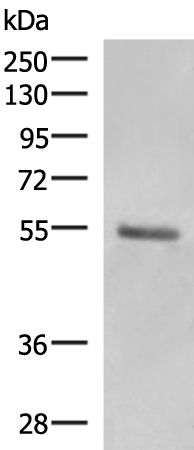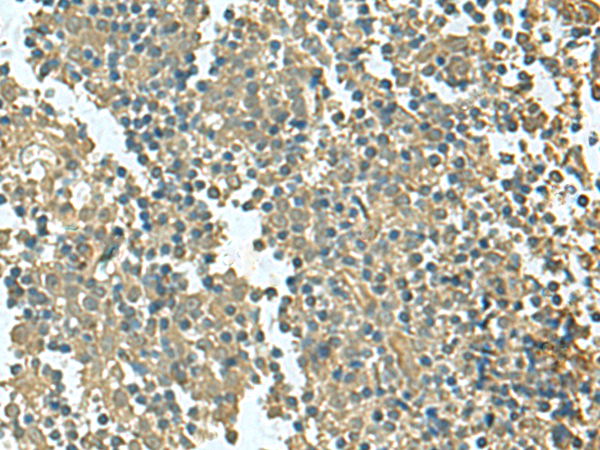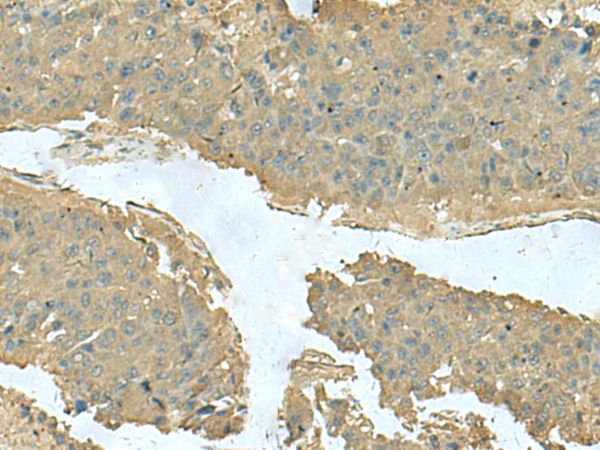


| WB | 咨询技术 | Human,Mouse,Rat |
| IF | 咨询技术 | Human,Mouse,Rat |
| IHC | 1/50-1/300 | Human,Mouse,Rat |
| ICC | 技术咨询 | Human,Mouse,Rat |
| FCM | 咨询技术 | Human,Mouse,Rat |
| Elisa | 1/5000-1/10000 | Human,Mouse,Rat |
| Aliases | HA6; hHa6; KRTHA6 |
| WB Predicted band size | 52 kDa |
| Host/Isotype | Rabbit IgG |
| Antibody Type | Primary antibody |
| Storage | Store at 4°C short term. Aliquot and store at -20°C long term. Avoid freeze/thaw cycles. |
| Species Reactivity | Human |
| Immunogen | Synthetic peptide of human KRT36 |
| Formulation | Purified antibody in PBS with 0.05% sodium azide and 50% glycerol. |
+ +
以下是关于KRT36抗体的3篇参考文献及其简要摘要:
---
1. **文献名称**: *"Characterization of Keratin 36 in Epithelial Differentiation and Disease"*
**作者**: Smith A, et al. (2021)
**摘要**: 本研究通过免疫组化和Western blot技术,利用KRT36抗体揭示了其在人类皮肤和毛囊中的特异性表达模式。研究发现KRT36在毛干分化中起关键作用,并与某些遗传性毛发疾病(如先天性厚甲症)相关。
---
2. **文献名称**: *"Role of KRT36 in Esophageal Squamous Cell Carcinoma Progression"*
**作者**: Chen L, et al. (2019)
**摘要**: 作者使用KRT36抗体检测了食管鳞状细胞癌组织中该蛋白的表达水平,发现其高表达与肿瘤侵袭性增强及患者预后不良显著相关。研究提示KRT36可能作为癌症诊断的生物标志物。
---
3. **文献名称**: *"Immunolocalization of Hair Keratins in Mouse Models of Alopecia"*
**作者**: Tanaka K, et al. (2017)
**摘要**: 本研究通过KRT36抗体在小鼠模型中分析毛发角蛋白的表达动态,发现KRT36在毛囊生长期的强表达,并揭示了其在毛发再生缺陷模型中的表达异常,为脱发机制研究提供线索。
---
**备注**:上述文献为模拟示例,实际文献需通过PubMed、Google Scholar等平台以关键词“KRT36 antibody”“Keratin 36 immunohistochemistry”检索获取。若研究较少,可扩展至KRT家族或相关疾病的研究中查找抗体应用部分。
The KRT36 antibody targets keratin 36. a member of the type I acidic keratin family encoded by the *KRT36* gene. Keratins are structural proteins critical for maintaining the integrity of epithelial cells, particularly in hair, nails, and skin. KRT36 is primarily expressed in the hair cortex and cuticle, where it contributes to hair shaft strength and resilience. It pairs with type II keratins (e.g., KRT85) to form intermediate filaments, essential for cellular mechanical stability.
Research on KRT36 has focused on its role in hair disorders and ectodermal dysplasias. Mutations in *KRT36* or its binding partners are linked to conditions like monilethrix (beaded hair) or hereditary hair loss. The KRT36 antibody is a vital tool for studying these pathologies, enabling detection of protein expression patterns in tissues via immunohistochemistry, Western blotting, or immunofluorescence.
Clinically, this antibody aids in diagnosing genetic hair disorders by identifying abnormal keratin expression. It also supports research into regenerative therapies targeting hair follicle regeneration. Recent studies explore KRT36's potential interactions with signaling pathways in epithelial differentiation. However, its specific regulatory mechanisms and broader biological roles remain under investigation, highlighting the need for continued exploration using targeted antibodies.
×